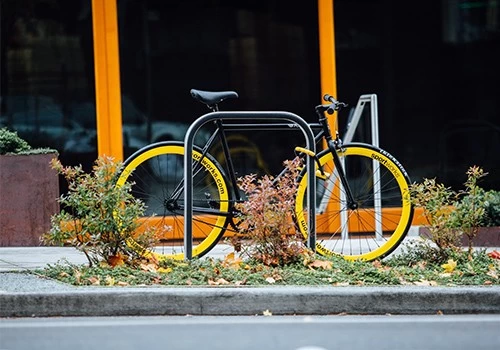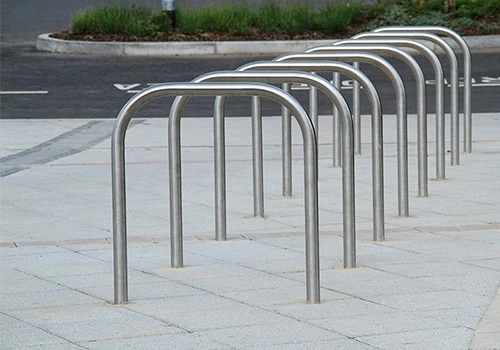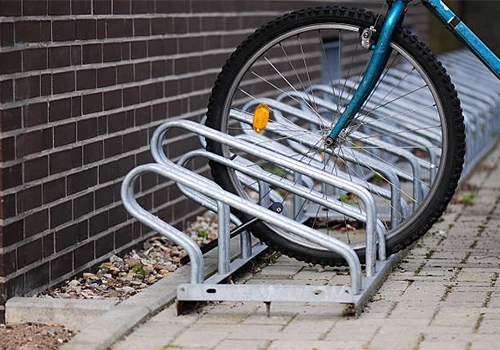Specifications
Model Number : PV-SC-001
Type: Bike parking and storage
Color:Yellow,Black,Green,Red,or Customized.
Style : both indoors and outside
Material : carbon steel
Loading: According to customer need
Size :195*23.2*75cm,200.55*23.2*75cm,or Customized.
Finish: hot-galvanized
Specifications
Model Number : PV-0081-01
Type: Bike parking and storage
Color:silver
Style : both indoors and outside
Material : carbon steel
Loading: According to customer need
Size :Height 1463mm, Depth 1114mm
Finish: hot-galvanized
Model Number : PV-0081-01
Type: Bike parking and storage
Color:Black
Style : both indoors and outside
Material : carbon steel
Loading: 2-10 bikes (According to customer need)
Size :Height 1463mm, Depth 1114mm
Finish: hot-galvanized
Model No.: PV-H1
Size: w605*D400*H330mm
Specification: Round tube:¢16*1.2mm
Finish: Power coated
Net Weight: 1.6 kgs
Packing size:6pcs/ctn
MOQ: 100pcs
Model Number : PV-0024-01
Material : carbon steel/stainless steel
Loading: according customer space size,we can design according the size
Size : W1977*D1130(depend on your parking space)*H2500mm
Finish: Powder coated ,hot-galvanized/electric polish
Packing size :2000*2000*2500mm(40 parking space )
Powder coated ,hot-galvanized/electric polish
Product number:PV-0046-01
Material:carbon steel
Specification:10.2*59*28CM or Customized.
MOQ:100PCS
Port:Shanghai
Trademark:PV
Model Number : PV-0081-01
Type: Outdoor Bike Parking Rack
Style : both indoors and outside
Material : carbon steel
Loading: 2-10 bikes (According to customer need)
Size :170.5*116*148CM
Finish: hot-galvanized
Model Number : PV-0055-01
Type: compact flat pack /slot
Color:black / silver /yellow/optional
Style :Outdoor/indoor
Material : carbon steel/ stainless steel
Capacity : park 6 bikes
Size : L1400*W1054*H840mm
Net weight :38KG
Finish: powder coating / hot galvanized /elctropolishing
Packing size :1490*860*160mm 1pcs/ctn
Product Name: Multi-Capacity Horizontal Two Tier Bike Parking Rack
Material: Carbon Steel
Finish: Powder coated
Post: 80mm * 80mm thickness: 3mm
Steel plate: thickness: 2mm
Dimension: 1325*1890*1830mm
Weight: 370 kg/set
Model: PV-0067-01
Material: stainless steel 304
Pipe: 50 mm* 2.5 mm
Size: 900*700 mm(L*W)
Surface treatment: polishing

In cities around the world, urban mobility is undergoing a profound transformation. As populations grow, congestion worsens, and sustainability goals take center stage, cities are rethinking how people move. Among the most impactful shifts is the rise of cycling as a viable, eco-friendly, and cost-effective mode of transportation. Yet, for cycling to reach its full potential in urban environments, one critical infrastructure element often overlooked is bicycle parking racks.
At first glance, a bicycle parking rack may seem like a simple, low-cost accessory. But in reality, its role in urban mobility extends far beyond providing a place to lock a bike. High-quality, strategically designed bicycle parking racks are economic drivers—reducing costs for cities, businesses, and commuters while generating tangible returns on investment (ROI). For municipalities, commercial properties, and institutions, investing in the right bicycle parking solutions is not just a matter of convenience; it is a strategic financial decision with long-term economic benefits.
In this article, we’ll explore the often-unseen economic impact of bicycle parking racks, from cost-savings in urban planning to ROI for businesses and communities. We’ll also highlight how our company’s innovative parking rack solutions are engineered to maximize these economic benefits, making them a smart investment for any urban mobility strategy.
Cities and businesses that neglect bicycle parking infrastructure often pay a steep price—even if those costs aren’t immediately obvious. Inadequate, poorly designed, or scarce bicycle parking creates a ripple effect of economic inefficiencies, impacting everything from traffic management to public health. Let’s break down these hidden costs:
1. Lost Revenue for Local Businesses
When cyclists can’t find safe, convenient parking near shops, restaurants, or offices, they’ll take their business elsewhere. A 2019 study by the League of American Bicyclists found that cyclists spend an average of 20% more per visit to local businesses than drivers, and they visit more frequently. Yet, without proper parking, this customer base is lost.
For example, a café in a busy urban area might lose 10–15 cyclist customers per day due to a lack of racks. At an average spend of
15pervisit,that’s150–225 in daily lost revenue , or up to82,125 per year. Multiply this across an entire district, and the economic impact becomes significant.
2. Increased Traffic Congestion and Infrastructure Costs
When cyclists are deterred by poor parking, many will switch to cars—adding to traffic congestion. Congestion costs cities billions annually in wasted fuel, lost productivity, and increased wear on roads. According to the Texas A&M Transportation Institute, the average urban commuter in the U.S. loses 54 hours per year to congestion, costing $1,080 per person in wasted time and fuel.
More cars also mean higher demand for parking garages, which are exponentially more expensive to build than bicycle racks. A single parking space in a multi-level garage costs between 20,000and 50,000 to construct, compared to 50–500 for a high-quality bicycle parking spot. For a city or business, choosing to prioritize car parking over bicycle parking is a costly long-term mistake.
3. Bicycle Theft and Its Economic Toll
Poorly designed or insecure parking racks are a magnet for bicycle theft. In the U.S. alone, over 300,000 bicycles are stolen each year, with only 10% recovered, according to the FBI. The economic impact is staggering: replacing a stolen bike costs an average of 500–1,500 per incident, and the emotional and productivity costs (e.g., missed work due to lack of transportation) add up.
For cities, bicycle theft also erodes trust in cycling as a viable commuting option, discouraging people from switching to bikes and perpetuating reliance on cars. This, in turn, increases the costs associated with car-centric infrastructure.
4. Legal and Regulatory Risks
Many cities are now mandating bicycle parking as part of urban development codes. For example, San Francisco requires commercial buildings to provide 1 bicycle parking space for every 100 square meters of floor area. Failure to comply can result in fines, delayed permits, or even project cancellations—costing developers and businesses time and money.
Inadequate parking also exposes cities to liability. If a cyclist’s bike is stolen due to a broken or poorly maintained rack on public property, municipalities may face lawsuits or claims, further straining budgets.

Investing in high-quality bicycle parking racks is not an expense—it’s an investment with measurable returns. When designed for durability, security, and convenience, these racks generate cost-savings and ROI across multiple fronts:
1. Lower Long-Term Maintenance Costs
Cheap, flimsy bicycle racks may seem like a budget-friendly choice, but they often need frequent replacement. A low-quality steel rack, for example, might rust, bend, or break within 2–3 years, requiring replacement at a cost of 100–300 per unit. In contrast, a high-quality rack made from galvanized steel or aluminum, like those we manufacture, can last 10–15 years with minimal maintenance.Over a 15-year period, the total cost of replacing a low-quality rack 5 times (every 3 years) would be 500–1,500. A single high-quality rack, costing 200–500 upfront, would cost 50–75% less over the same period. For a city installing 1,000 racks, this translates to savings of 300,000–1,000,000.
2. Reduced Theft and Insurance Claims
Security is a key feature of premium bicycle parking racks. Our racks, for example, include reinforced locking points, anti-cut materials, and designs that prevent tipping or tampering. These features drastically reduce theft rates.A study by the National Bike Registry found that bikes parked in secure, well-designed racks are 80% less likely to be stolen than those in flimsy or exposed racks. For a university campus with 5,000 daily cyclists, this could mean 400 fewer thefts per year (assuming a baseline theft rate of 10%). At an average replacement cost of 800perbike,thistranslatesto320,000 in annual savings on insurance claims and replacement costs.
3. Increased Foot Traffic and Revenue for Businesses
Businesses that install visible, accessible bicycle racks report a 15–25% increase in cyclist customers, according to a 2022 survey by the Bicycle Product Suppliers Association. For a retail store with 500,000in annual revenue,a 20100,000 in additional sales—far exceeding the 500–1,000 cost of installing a high-quality rack.Restaurants, in particular, benefit: cyclists often stay longer than drivers, ordering additional items like coffee or dessert while their bikes are safely parked. Over time, this increased patronage creates a steady stream of revenue that dwarfs the initial investment in parking.
4. Savings on Urban Infrastructure
Cities that prioritize bicycle parking reduce their reliance on car-centric infrastructure. Every 100 cyclists who commute daily instead of driving can save a city approximately $100,000 per year in road maintenance, parking garage construction, and traffic management costs, according to the American Public Transportation Association.
Bicycle parking racks also require far less space than car parking. A single car parking spot (9 square meters) can accommodate 8–10 bicycle parking spaces. This efficiency reduces the need for land acquisition and construction, freeing up urban space for parks, housing, or commercial development—all of which generate additional economic activity.
At Suzhou Pioneer Vehicle, we engineer our bicycle parking racks with one goal in mind: to deliver the highest possible economic value to our clients. Every design choice—from materials to security features—is optimized to reduce costs, increase ROI, and support long-term urban mobility goals. Here’s how our products stand out:
1. Durable Materials for Longevity
We use only premium materials to ensure our racks withstand harsh weather, heavy use, and vandalism. Our galvanized steel racks are coated with a zinc layer that resists rust and corrosion, even in coastal or high-humidity environments. For lighter, more portable options, our aluminum racks are 30% lighter than steel but equally strong, with a powder-coated finish that prevents chipping and fading.
The result? Racks that last 15+ years with minimal maintenance. For a city or business, this means lower replacement costs and a higher ROI over the product lifecycle.
2. Security Features That Reduce Theft-Related Costs
Our racks are designed with theft prevention as a core feature. Key security elements include:
These features have been proven to reduce theft rates by up to 90% in pilot programs with universities and urban districts. For example, after installing our racks at a downtown shopping center in Portland, Oregon, bicycle thefts dropped from 12 per month to 1, saving local businesses an estimated $50,000 in lost revenue and insurance claims.
3. Space-Efficient Designs for High-Density Areas
Urban space is expensive, which is why our racks are engineered to maximize parking capacity in minimal square footage. Our “CompactGrid” model, for example, fits 10 bikes in the space of a single car parking spot, while our “VerticalStor” vertical rack doubles capacity by allowing bikes to be parked vertically (ideal for tight spaces like office lobbies or transit stations).
For businesses and cities, this means more parking spots without expanding their footprint—reducing the need for costly land purchases or construction. A retail complex, for instance, can accommodate 50 bikes with our CompactGrid racks in the same space that would fit 5 cars, freeing up room for additional storefronts or outdoor seating.
4. Customization to Meet Specific Needs
Every urban environment is unique, which is why we offer customizable rack solutions. Whether a client needs racks that match a historic district’s aesthetic, are wheelchair-accessible, or can accommodate e-bikes (which are heavier and require sturdier support), we tailor our designs to fit.
This customization reduces the risk of investing in racks that don’t meet local needs. For example, our e-bike-specific racks include reinforced supports and charging ports, addressing the growing demand for e-bike infrastructure without requiring future upgrades. This forward-thinking design saves clients from costly retrofits as urban mobility trends evolve.

As cities continue to prioritize sustainability and active transportation, the role of bicycle parking racks will only grow. E-bike adoption is projected to increase by 70% by 2030, creating demand for specialized parking solutions. Meanwhile, urban populations are booming, making space-efficient infrastructure more critical than ever.
In this context, bicycle parking racks are no longer an afterthought—they are essential components of a resilient, cost-effective urban mobility system. Cities and businesses that invest in high-quality racks today will reap the economic rewards for decades: lower infrastructure costs, increased revenue, and healthier, more vibrant communities.
At Suzhou Pioneer Vehicle, we’re proud to be at the forefront of this movement. Our racks are more than just metal structures—they are tools for economic growth, designed to save money, reduce waste, and make cities better places to live and work.Ready to calculate the ROI of upgrading your bicycle parking infrastructure? Contact our team today for a free, personalized assessment. Together, we can build a more sustainable—and profitable—urban future.Suzhou Pioneer Vehicle is a leading manufacturer of high-quality, durable bicycle parking racks for urban, commercial, and institutional use. With 20+ years of experience, we specialize in designing solutions that balance security, durability, and cost-effectiveness. Learn more about our products at chinabikerack.